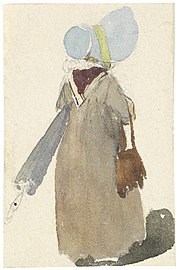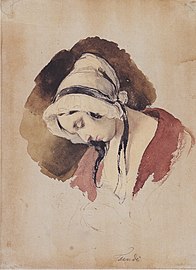Peter Fendi | |
|---|---|
 Self-portrait (1830) | |
| Born | 4 September 1796 |
| Died | 28 August 1842 (aged 45) |
| Nationality | Austrian |
| Known for | Painter, Lithographer |

Peter Fendi (4 September 1796 – 28 August 1842)[1] was an Austrian court painter,[2] portrait and genre painter, engraver, and lithographer.[3] He was one of the leading artists of the Biedermeier period.[4]
About[edit]
Peter Fendi was born in Vienna on 4 September, 1796, to Joseph and Elizabeth Fendi. His father was a schoolmaster.[1] He fell from a changing table as an infant, an accident which caused irreparable damage to his spine.[5] Fendi demonstrated a talent for drawing from childhood. He was admitted to the St. Anna's Academy of Fine Art[1] in 1810[5] at the age of thirteen, where he studied for three years[1] under Johann Martin Fischer, Hubert Maurer and Johann Baptist von Lampi the Elder.[5]
Fendi met Joseph Barth, an art collector and the personal ophthalmologist of Joseph II, and through Barth's connections to other influential artists, in 1818 Fendi found a job at the Imperial Gallery of Coins and Antiquities,[1][6][7] where he worked as a draughtsman and engraver.[8] Fendi received a gold medal in 1821 for his oil painting Vilenica,[9] and was elected a member of the Academy of Fine Arts Vienna in 1836.[8]
Both nobles and commoners occasionally employed Fendi to give instruction in drawing and painting, and later in life teaching took up more of his time; his pupils included Carl Schindler and Johann Friedrich Treml.[10] He died on 28 August 1842.[1]
Works[edit]
Fendi painted in oil and watercolours, as well as working with printing, etching, lithography and wood carving.[1][10] Multicolored prints by Fendi are considered pioneering achievements in the field of lithography.[1] Fendi is remembered for his genre scenes,[8] influenced by Dutch painters such as Adriaen Brouwer, Adriaen van Ostade and Rembrandt. Other influences on Fendi's artistic development included the works of Italians such as Giovanni Bellini, Tintoretto, Titian, and Paolo Veronese, which he saw on a trip to Venice in 1821.[11] He is also well known for his portraits of the aristocracy.[12]
Fendi engraved a series five of Austrian banknotes that were issued in 1841.[13]
His works are preserved in the Albertina Museum, the Austrian Gallery in the Belvedere, Kunsthistorisches Museum, and in the collections of the Prince of Liechtenstein in Vaduz.[1]
Gallery[edit]
-
The Sad Message
-
The Eavesdropper
-
The Sower
-
Woman with Turquoise Hat and Umbrella
-
The Poor Officer's Widow
-
Maid with a Letter
-
Scene of the Flooding
References[edit]
- ^ a b c d e f g h i "Painters: 200th Birthday of Peter Fendi". AEIOU, Federal Ministry for Education, Science and Culture (Austria). Archived from the original on 22 January 2021. Retrieved 7 February 2010.
- ^ Bullough & Bullough 1994, p. 48
- ^ Getty Research - Union List of Artist Names - Peter Fendi - Full Record Display Getty Foundation
- ^ Parsons 2008, p. 197
- ^ a b c Koschatzky 1988, p. 106
- ^ Waissenberger 1986, p. 164.
- ^ The Imperial Gallery of Coins and Antiquities was originally part of the Imperial Art Collection, which was later transferred the Kunsthistorisches Museum
- ^ a b c "Peter Fendi". Idburyprints.com. Cotswolds, England: Idbury Prints Limited. Archived from the original on 24 September 2009. Retrieved 7 February 2010.
{{cite web}}: CS1 maint: unfit URL (link) - ^ "The book about Karst" (PDF). ProGEO Newsletter. ProGEO. 1998. Retrieved 12 September 2022.
- ^ a b Norman 1987, p. 84.
- ^ Waissenberger 1986, p. 166.
- ^ Howard Gibbs 1997, p. 290
- ^ Hessler, Gene (2005). The International Engraver's Line. Gene Hessler. p. 100. ISBN 978-0976841104.
Further reading[edit]
- Parsons, Nicholas (2008), Vienna: A Cultural History, Oxford University Press US, ISBN 978-0-19-537607-4.
- Bullough, Vern L.; Bullough, Bonnie (1994), Human Sexuality: An Encyclopedia, Taylor & Francis, ISBN 978-0-8240-7972-7.
- Howard Gibbs, Christopher (1997), The Cambridge Companion to Schubert, Cambridge Companions to Music, Cambridge University Press, ISBN 978-0-521-48424-4.
- Koschatzky, Walter (1988), Viennese Watercolors of the Nineteenth Century, Harry N. Abrams, Inc., ISBN 978-0-8109-1375-2.
- Waissenberger, Robert (1986), Vienna in the Biedermeier Era, Rizzoli, ISBN 0-8478-0715-0.
- Norman, Geraldine (1977), Nineteenth Century Painters and Painting: A Dictionary, Thames & Hudson, ISBN 0-520-03328-0.






